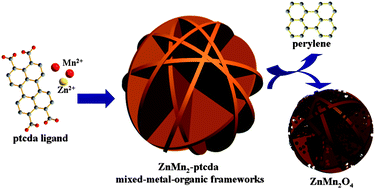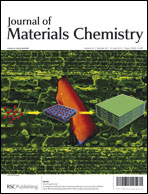A two-step process that differs in important details from previous methods used to prepare ZnMn2O4 nanoplate assemblies has been reported. This material was prepared by thermal transformation of metal–organic nanoparticles into metal–oxide nanoparticles based on the “escape-by-crafty-scheme” strategy. Firstly, the nanoscale mixed-metal–organic frameworks (MMOFs) precursor, ZnMn2–ptcda (ptcda = perylene-3,4,9,10-tetracarboxylic dianhydride), containing Zn2+ and Mn2+, was prepared by the designed soft chemical assembly of mixed metal ions and organic ligands at a molecular scale. In a second step, the MMOFs are thermally transformed into spinel structured ZnMn2O4 with morphology inherited from the MMOFs precursors. The well-crystallized spinel structure can be formed by thermal treatment of ZnMn2–ptcda at 350 °C, and is formed at temperatures ≥450 °C using the co-precipitation method. This “escape-by-crafty-scheme” strategy can be extended to the preparation of other spinel metal–oxide nanoparticles, e.g. CoMn2O4, and NiMn2O4, with well-defined morphology inherited from the metal–organic precursors. The ZnMn2O4 nanoplate assemblies thermally treated at 450 °C have potential application in lithium ion batteries as anode materials, which show high specific capacity and good cyclability.

You have access to this article
 Please wait while we load your content...
Something went wrong. Try again?
Please wait while we load your content...
Something went wrong. Try again?


 Please wait while we load your content...
Please wait while we load your content...